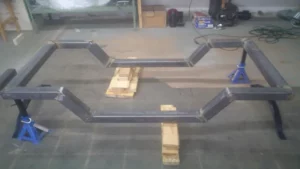If you are someone who enjoys working on your own vehicle, then the issue of whether or not you need jack stands might have come up in your mind. While a lot of people think they can get away without using jack stands, it is essential to take the necessary precautions, especially when working underneath a car. Jack stands are not just recommended but mandatory when it comes to the safety of both yourself and your vehicle.
They provide stability and support, keeping the car in place and preventing it from falling or rolling off the jack. It’s like wearing a seatbelt while driving; you don’t necessarily need it all the time, but it’s always better to be safe than sorry. In this blog, we will explore why you need jack stands and why neglecting them can have catastrophic consequences.
Understanding Jack Stands
If you’re wondering “do I need jack stands?” the answer is almost always yes. Jack stands are essential tools for any mechanic or DIY car enthusiast. They provide a stable and secure support for your vehicle while you work on it, ensuring your safety and preventing accidents.
Using a jack stand allows you to take the pressure off your jack, making it less likely to fail and tip over. In addition, it provides a stable platform for you to work on, which is especially important when working under the car. When choosing jack stands, make sure they are rated to support the weight of your vehicle and follow the manufacturer’s instructions carefully.
Don’t take shortcuts or try to save time, your safety is too important. Always use jack stands and feel confident knowing your vehicle is secure.
What are jack stands and how do they work?
Jack stands are mechanisms used to lift and support vehicles while performing maintenance or repairs. They work along with a hydraulic jack to ensure the vehicle remains stable and secure. Jack stands come in different sizes and weight limits to cater to various types of vehicles and the loads they carry.
They are designed to fit under the vehicle’s pinch welds or frame and are adjustable to ensure adequate support. It’s crucial to choose the correct jack stand weight limit to avoid any accidents or damage to the vehicle. When using jack stands, make sure the surface is level and stable and set up the stands appropriately, one under each pinch weld or frame.
Overall, jack stands provide a safe and reliable approach to lift vehicles, ensuring the mechanic’s safety and the vehicle’s stability.

Why are jack stands important for car safety?
Jack stands are vital for ensuring car safety during repair work or maintenance. These sturdy metal supports are designed to hold the weight of a car safely off the ground while you work underneath, providing a stable platform to prevent accidents. Understanding how jack stands work is paramount to keeping your vehicle stable and safe.
They come in a variety of shapes and sizes, so it’s important to choose the right ones to suit your car’s weight and height. When using jack stands, be sure to follow the manufacturer’s guidelines carefully, including placing them in the proper location on your car’s frame. Neglecting to use jack stands could result in your vehicle collapsing, causing serious injury or worse.
Overall, investing in a good set of jack stands is essential for anyone working on their car and prioritizing safety above all else.
When to Use Jack Stands
If you’re wondering when to use jack stands, the answer is pretty simple – any time you need to work underneath your vehicle. Whether you’re changing the oil, rotating the tires, or doing more extensive repairs, using jack stands is a critical safety measure. It’s important to remember that a car jack is not enough to keep your car secure while you’re working on it.
Jacks can be unstable and can fail under the weight of a vehicle if it’s not positioned properly. Jack stands, on the other hand, are designed to support the weight of a car and can lock into place, meaning they won’t move around or fall over while you’re working. So if you want to ensure your safety while working on your vehicle, always use jack stands to secure it and prevent accidents.
When working on a vehicle that requires lifting off the ground
When working on a vehicle, it’s important to lift it off the ground to ensure you have ample access to the parts that need fixing. However, this can be a dangerous task without the proper precautions. That’s where jack stands come in.
Jack stands are a type of support that holds a vehicle in place once it has been lifted. They are essential for any repairs or maintenance that require the wheels to be off the ground. When using a jack stand, make sure you have it placed on a stable surface and that the vehicle is properly aligned.
Never use a jack stand on an uneven or sloped surface. It’s also important to have the correct weight rating for your vehicle, as using an unsuitable jack stand can lead to injury or damage to your car. By taking the time to use jack stands properly, you’ll ensure your safety and increase your confidence when working on your vehicle.
When using a hydraulic jack
When using a hydraulic jack, it’s essential to know when to use jack stands. A common mistake people make is relying solely on the jack to hold up their vehicle while working underneath it. However, hydraulic jacks can fail or leak, causing the weight of the vehicle to collapse suddenly and dangerously.
That’s why it’s crucial to always use jack stands, which are placed underneath the vehicle to support its weight instead of relying solely on the hydraulic jack. Make sure to use the appropriate jack stands for your specific vehicle’s weight, and be sure to position them in the correct location on the chassis or frame. Remember, it’s better to be safe than sorry, so always use jack stands when working underneath your vehicle to avoid potential disasters.
When using a scissor jack
When using a scissor jack, it’s important to know when to use jack stands. Jack stands provide added safety and stability when you’re working on your vehicle. While scissor jacks are great for changing a tire, they’re not meant to hold the weight of the vehicle for an extended period of time.
That’s where jack stands come in – they provide a sturdy base to support the car while you work underneath it. Make sure to place the jack stands on a solid surface and position them at the correct support points on your vehicle. Always double-check that the stands are securely in place before crawling under the car.
It may seem like an extra step, but using jack stands can prevent accidents and ensure that you’re able to complete your repair job safely and effectively. Remember, when it comes to working on your car, safety should always be your top priority.
Types of Jack Stands
If you’re someone who works on your own car, you definitely need jack stands. They’re a vital tool to keep you safe while under your vehicle. There are various kinds of jack stands available that you can choose from.
The first type of jack stand is known as the tripod design, which has three legs that give it extra stability. The second type is known as the pin design that can adjust to different heights. The third type of jack stand is the ratchet design, which allows for easy height adjustments.
The fourth type is known as the screw design, which has a threaded rod to adjust the height. It’s important to choose the right type of jack stand depending on your needs and the weight of your vehicle. So, if you’re planning to work on your car or replace its tires, you definitely need jack stands; otherwise, you’re risking serious injury.
Therefore, invest in the proper type of jack stand to ensure your safety while working on your car.
Tripod stand vs. ratchet stand vs. pin stand
When it comes to supporting your vehicle, jack stands are an essential tool to have in your garage. However, there are different types of jack stands available in the market, and each has its benefits and shortcomings. Tripod stands, also known as three-legged stands, are designed for lighter loads and are easily adjustable, making them ideal for small vehicles.
Ratchet stands, on the other hand, are more robust and can handle heavier loads. They are also more stable and provide better stability for your car. Pin stands, which are often used in professional garages, are ideal for lifting heavy vehicles as they offer maximum stability and are engineered to last.
The type of jack stand you choose depends on the weight of the car and the job at hand. Always ensure that you purchase high-quality jack stands that conform to safety standards and use them correctly to avoid accidents. It is always best to err on the side of caution when it comes to your safety, so don’t compromise on the quality of your jack stands.
Minimum weight-bearing capacity for your vehicle
If you’re planning on investing in a set of jack stands for your vehicle, it’s important to choose the right ones that can bear the weight of your car or truck. The minimum weight-bearing capacity for jack stands varies depending on the size and weight of your vehicle. For smaller cars, a minimum weight-bearing capacity of 2 tons is usually sufficient, while larger trucks and SUVs may require jack stands with a weight capacity of 3-4 tons.
It’s crucial to choose quality jack stands that meet safety standards, particularly if you’ll be working underneath your vehicle. There are several types of jack stands available, including tripod, ratchet, and pin stands. Tripod stands are the most stable, with three legs for increased stability, while ratchet stands are best for quick adjustments and have a more compact design.
Pin stands are the most basic type and offer a straightforward design that’s easy to use. Whatever type you choose, make sure it’s rated to handle the weight of your vehicle and follow manufacturer instructions carefully to ensure safe use. With the right jack stands, you can safely work on your vehicle and maintain its performance without worrying about accidents or damage.
Conclusion and Safety Tips
In conclusion, asking whether you need jack stands is like asking whether you need a life jacket while kayaking – technically, you could get away without one, but the potential consequences just aren’t worth it. There’s no need to take unnecessary risks when it comes to your safety and the safety of those around you. So next time you’re working on your car, don’t forget to grab your trusty jack stands!”
FAQs
Do I need to use jack stands when lifting my vehicle?
Yes, it’s highly recommended to use jack stands when lifting your vehicle. This provides added safety and stability while working underneath your car.
How many jack stands do I need?
Typically, you will need four jack stands to safely lift and support your car. Two for the front and two for the back.
Can I use bricks or cinder blocks instead of jack stands?
No, using bricks or cinder blocks is not safe and can result in serious injury or damage to your car. Stick to using proper jack stands.
Can I leave my car on jack stands overnight?
No, it’s not recommended to leave your car on jack stands for an extended period of time. Jack stands can shift or fail over time, so it’s best to only use them for short periods of time.
How much weight can jack stands hold?
Jack stands have weight limits that can vary depending on the brand and type. Always check the manufacturer’s specifications and only use jack stands that are rated for the weight of your vehicle.
Can I substitute a hydraulic jack for a jack stand?
No, a hydraulic jack is not a substitute for a jack stand. They serve different purposes and should be used together for maximum safety.
How do I properly position jack stands under my vehicle?
Always consult your vehicle’s owner’s manual for specific jack stand placement instructions. Generally, place the jack stands on a flat and level surface, positioning them underneath designated lift points on your car.






